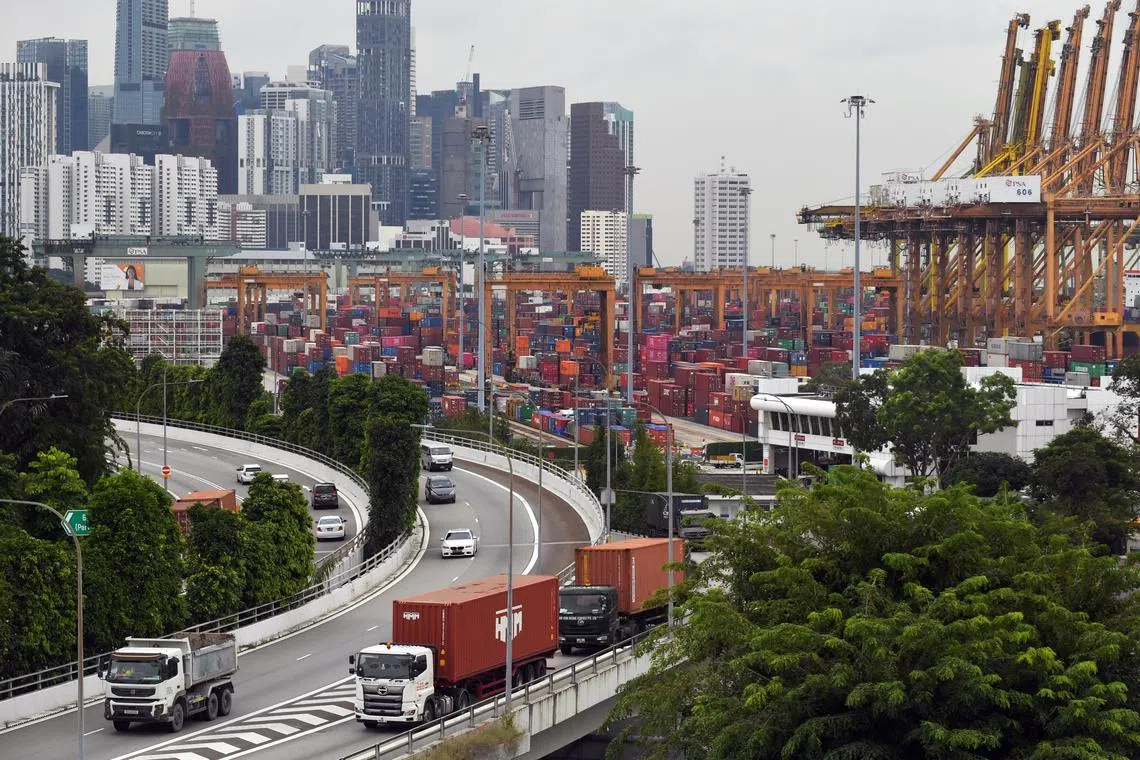Singapore avoids technical recession with economy growing 0.3% quarter on quarter
Sign up now: Get ST's newsletters delivered to your inbox

Gross domestic product also grew 0.7 per cent year on year in the April-June period.
PHOTO: ST FILE
Follow topic:
SINGAPORE - Singapore’s economy expanded by 0.3 per cent in the second quarter of 2023 from the previous three months, narrowly avoiding a technical recession or two consecutive quarters of contraction.
Gross domestic product (GDP) also grew 0.7 per cent year on year in the April-June period, according to advance estimates from the Ministry of Trade and Industry (MTI) on Friday.
In the first three months of 2023, the economy had grown by 0.4 per cent year on year, slowing from the 2.1 per cent expansion in the previous quarter. On a quarter-on-quarter seasonally adjusted basis, it shrank 0.4 per cent, a reversal from the 0.1 per cent growth in the fourth quarter of 2022.
The quarter-on-quarter contraction in the first three months of the year,
Despite dodging a recession, economists were still rather gloomy about the outlook for Singapore’s economy.
Growth in the second quarter was again weighed down by the trade-driven manufacturing sector, which contracted further on weakness in the global economy and the electronics down cycle, the ministry said.
However, the service sector delivered an upside surprise.
Barclays Bank senior economist Brian Tan said: “Details indicate that the service sector recovery, which we have been arguing would help offset the manufacturing downturn, was the source of the upside.”
Still, he said that overall, the economy is headed for a much lower pace of growth than 2022’s 3.6 per cent.
“With first-half GDP growth coming in at 0.6 per cent year on year, we reduce our full-year 2023 forecast further to 1 per cent from 1.5 per cent,” he said.
Barclays’ prediction is in the lower half of MTI’s forecast range of 0.5 per cent to 2.5 per cent for the whole of 2023.
MTI did not comment on that estimate in its Friday statement. But in May, it had added guidance to the forecast, saying growth is likely to come in at around the midpoint of the range.
Its flash estimates showed the manufacturing sector contracted 7.5 per cent year on year in the second quarter, sharper than the 5.3 per cent drop in the previous quarter.
The weak performance of the sector was due to output declines across all clusters, except for transport engineering.
On a quarter-on-quarter seasonally adjusted basis, manufacturing shrank at a slower pace of 1.3 per cent in the second quarter, compared with the 4.5 per cent contraction in the preceding quarter.
In the service sectors, the wholesale and retail trade, and transportation and storage sectors collectively grew by 2.6 per cent year on year in the second quarter, a turnaround from the 0.7 per cent contraction in the previous quarter.
The group of sectors comprising the information and communications, finance and insurance and professional services sectors grew by 1.5 per cent year on year in the second quarter, extending the 1.3 per cent growth in the previous quarter.
Accommodation and food services, real estate, administrative and support services and other services expanded by a combined 6.1 per cent year on year.
The construction sector grew by 6.6 per cent year on year in the second quarter, extending the 6.9 per cent growth in the first quarter.
Growth during the quarter was supported by expansions in both public- and private-sector construction output, MTI said.
On a quarter-on-quarter seasonally adjusted basis, construction expanded by 2.6 per cent in the second quarter, accelerating from the 0.3 per cent growth in the preceding quarter.
Ms Selena Ling, chief economist and head of treasury research and strategy at OCBC Bank, noted that an anticipated recovery in the global electronics industry, especially for semiconductors, appears to have been delayed towards the fourth quarter of 2023 or even early 2024.
“So Singapore’s manufacturing slump may persist into that third quarter at least,” she said.
In addition, there is little hope for an imminent strengthening of China’s placid recovery.
“At this juncture, the preliminary indications from the June forward-looking economic indicators for China suggest a further deceleration in growth momentum,” she said.
With weaker global demand for electronics and a sluggish outlook for China,


